Our comfort is ensured by engineering systems, and their component is pipelines, so pipes in our homes are inevitable. But their appearance, even if they are new and just changed, is not the most attractive. Therefore, there is a natural desire to hide them. About how to hide the pipes in the toilet and we will talk today – it is in this small room is usually the most of them.

Hide the pipes in the toilet can be in different ways, but most of the methods involve creating walls of different materials. If you choose this method, it is better to replace the old pipes with new ones in advance – both water and sewer. Hide behind the wall of old communications is definitely not worth it, it is better to choose a lighter version, which will provide access to the pipes at any time.
Inhoud van het artikel
How to make a box from drywall
You can close the pipes in the toilet by making a box of drywall. This is probably the most popular solution. All because the technology is very plastic, you can hide pipes of any configuration. Another nice bonus – multiple options for finishing: lay tiles on the glue, level the surface with putty, then paint or wallpaper.
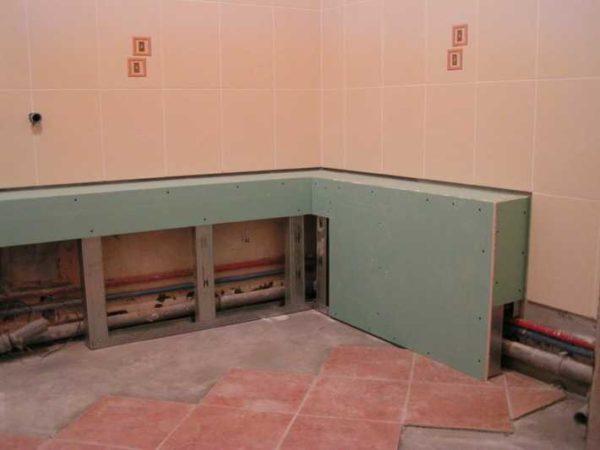
Features
If you choose such a close pipes in the toilet, there are several points that need to be taken into account. First – to all key nodes – meters, filters, etc., it is necessary to have access. To the shut-off taps it is desirable that access is quick. There are several options:
- make one panel hinged or swivel (hinged);
- part of the panel can be removable, fastening on a couple of self-tapping screws and/or magnets;
- put a hatch (plastic or invisible hatch under the tile finish.
It is possible, of course, to make the design non-disassembled, but if necessary, you will have to break everything, then restore, and problems happen even with new pipes.

The second – tiles, if you finish it, it is better to glue on a special glue, not put on a mixture of cement and sand. The layer of glue is required thinner its mass is less. Under these conditions, it will be easier to remove/lift the cover.
The order of work
First determine how your box will look like. It is desirable to plan everything so that it not only covers the pipes, but, if possible, also carried a functional load. For example, if the pipes pass down along the wall on the right or left, which happens if the toilet is installed hygienic shower, the box can be made a little higher, and on its upper part put various necessary small things.
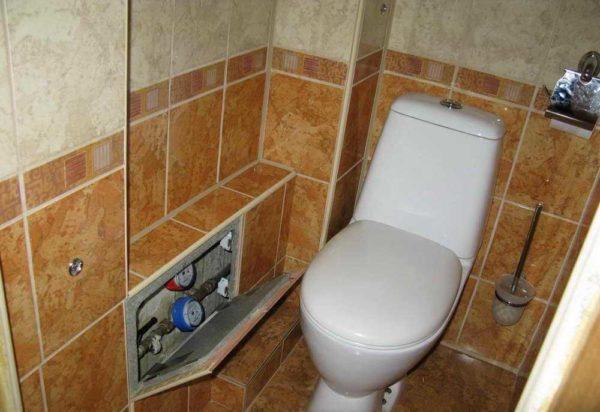
If you close the risers that pass in one of the corners behind the toilet bowl (the layout of standard Khrushchev toilets), it makes sense to close not only that corner, but to close the entire wall, making a cabinet out of it. Shelves can be open or closed (with doors or without), but in small apartments it is very convenient.
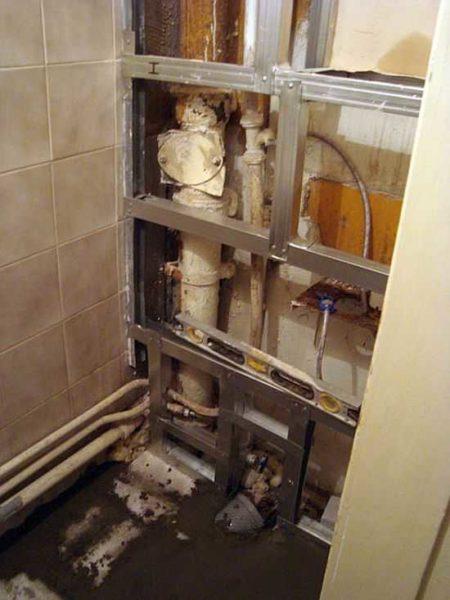
Having determined how your box will look like, on the walls, floor, markings are applied. Then take galvanized profiles for drywall. Down and on the sides goes the bearing profile – PN (UW) – without bent sides. Since the constructions are small, the profile 50*40 mm is enough. On the lintels goes rack profile – PS (CW) – its width is also 50 mm, and the depth at will, can be small.
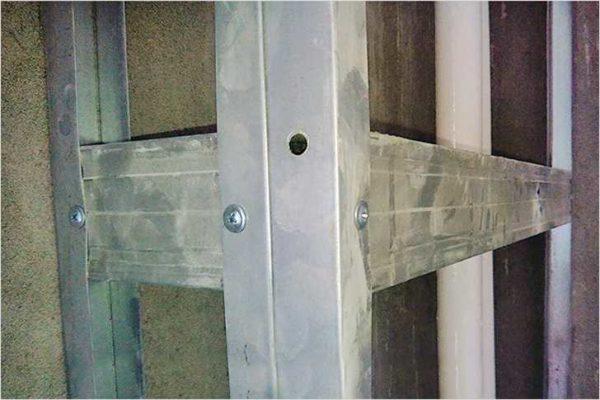
The lintels are cut to size (with metal scissors) and fastened with self-tapping screws. With a small distance – up to 50 cm – one at each end is enough, with a larger beam it is better to put two. The step of installation of the posts is about 60 cm, lintels – about the same step. In the place of fixing the door (if such is provided) put a reinforced – double profile.
The assembled frame is covered with gypsum cardboard, cutting it to size. Fix them with small self-tapping screws with a screw on the end (TEX 3,5*9,5 mm). Install the fasteners around the perimeter and in places where the lintels/struts go, the step – 20 cm. When screwing it is necessary to make sure that the cap slightly sunk into the plasterboard, but at the same time did not break through the cardboard.
You can read more about working with drywall here.
After paneling there are finishing works, and they depend on the chosen finish. Under painting and wallpaper, the box is spackled completely, under tile laying only the heads of the screws are covered with putty.
What else can be used to make a box for pipes in the toilet?
Not everyone likes to work with gypsumcarone and profiles to them. In this case, the frame can be assembled from wooden dry bars. If desired, they can (and in principle should) be treated with antibacterial compositions – so that they do not rot.
Instead of drywall, you can use OSB, moisture-resistant plywood or flat asbestos-cement sheets. All these materials are difficult to call 100% environmentally friendly, but many people are more accustomed to work with them. All of them are characterized by moisture resistance, convenient in processing, so not a bad option. On asbestos, by the way, the tiles lie perfectly, better than on all other materials, including gypsum board.
Make the back wall in the toilet from plastic
Hide the pipes in the toilet can be hidden behind plastic panels. This way to close the pipes in the toilet is the cheapest, but also the most short-lived. Plastic is easily squeezed through, so you need to be careful.
Now a little about aesthetics. If the finishing of the walls in the toilet is planned from the same plastic, there are no problems at all – all in the same style. If the wall finish is different, there are two ways out – to find plastic panels close in color or play on contrasts, adding a couple more details of the same color.
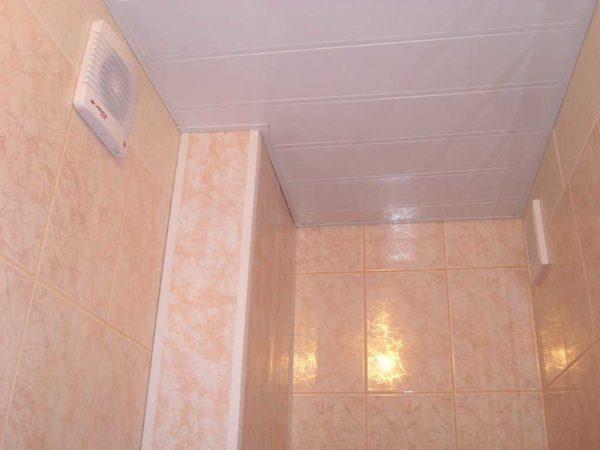
Cover the pipes in the toilet with plastic panels is simple. First, a frame is assembled, but already wooden. It is attached to the walls and floor with dowels. Since the design is small, it will be perfectly held on nails, large loads are not expected anyway – plastic can withstand only a very small weight.
To the wooden frame are fixed starter profiles for plastic panels, and in them are inserted sections of panels of the required length. They have a connection of the type – stud / groove, installed without gaps. Plastic is attached to the frame using staples and a construction stapler. To provide free access to pipes for repair or prevention in the box / wall of plastic make doors. In this case, you can install factory plastic hatches – they are light and quite fall into the style of rooms finished with plastic panels. Who does not like this option, can make the doors themselves, making a frame also from wooden slats and covering them separately with plastic. There is another option – leave a few slats unfastened and remove them if necessary.
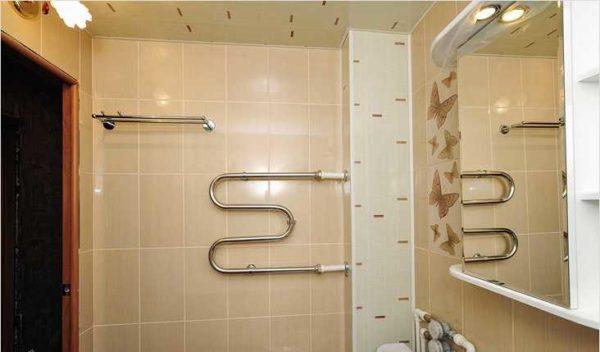
When buying, choose wall plastic panels (there are also ceiling panels) – they have thicker walls, harder to squeeze through. If you plan to use the upper surface of the box, it is better to lay a sheet of plywood (moisture-resistant) under the plastic.
Roller shutters in the toilet
The easiest way to close the pipes in the toilet is to put sanitary roller shutters (roller blinds, rollers). This option is ideal if you need to close the entire back wall. On the sides are installed guides, the top is attached to the bobbin with strips, that’s it, the installation is over, you can use.
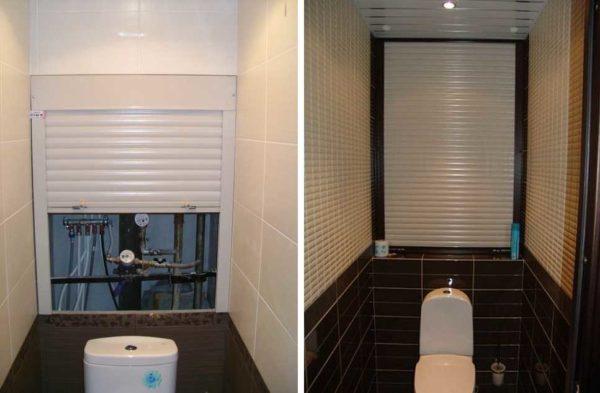
The minus of this option is the price of the roller blinds. It bites. But you can at any time lift the roller shutter that closes the pipes, and you can repair. There is still a way to reduce the price – the roller shutter is not put from floor to ceiling, and close it only the central part, where all the connections are located.
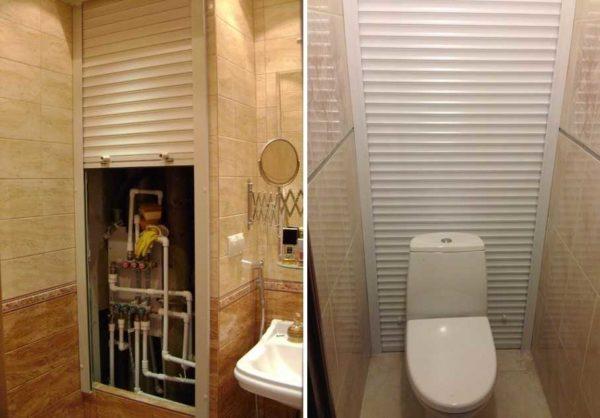
Even if it is necessary to close not the whole wall, but only a part of it, you can build a wall of GKL or wall foam blocks and already to this wall to attach roller shutters.
How else to hide pipes in the toilet
In small-sized apartments, every centimeter of space counts and just so close at least some part of the room – a real luxury. Then you can close the pipes by making a utility closet. For this purpose, narrow toilets in Khrushchevkas are an ideal option.
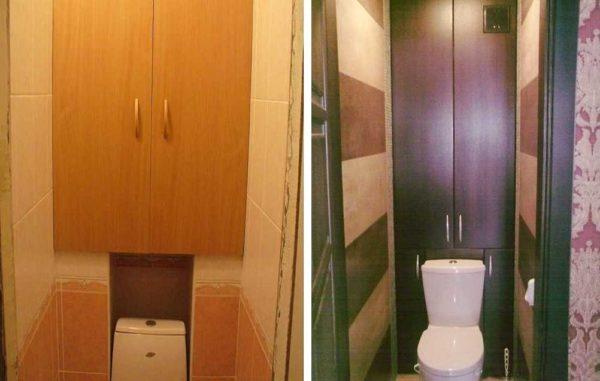
To the walls on both sides are attached to the strips, to them – doors on hinges. Shelves are assembled on the spot. They can be made removable to provide access to the pipes if necessary.
What to make the doors of? The simplest option – from laminated chipboard, but you can order them from MDF. They will make them according to your dimensions of the shops that are engaged in the manufacture of furniture. If you also pick up the color in the tone of the main finish or make a cabinet of the same color as the front doors, you will get a good interior.
A very budget-friendly way to make the back wall of the toilet attractive is to use horizontal or vertical blinds. With the installation is no bother at all, the only thing – you need to find the right size. Then nail the bar to the ceiling, and to it to attach the blinds themselves.

When selecting too, it is important to guess the color – or pick up the tone, or use contrast. And by the way, plastic horizontal blinds will be more practical in this case – they do not bend if you accidentally touch them. In general, not a bad option by all accounts.

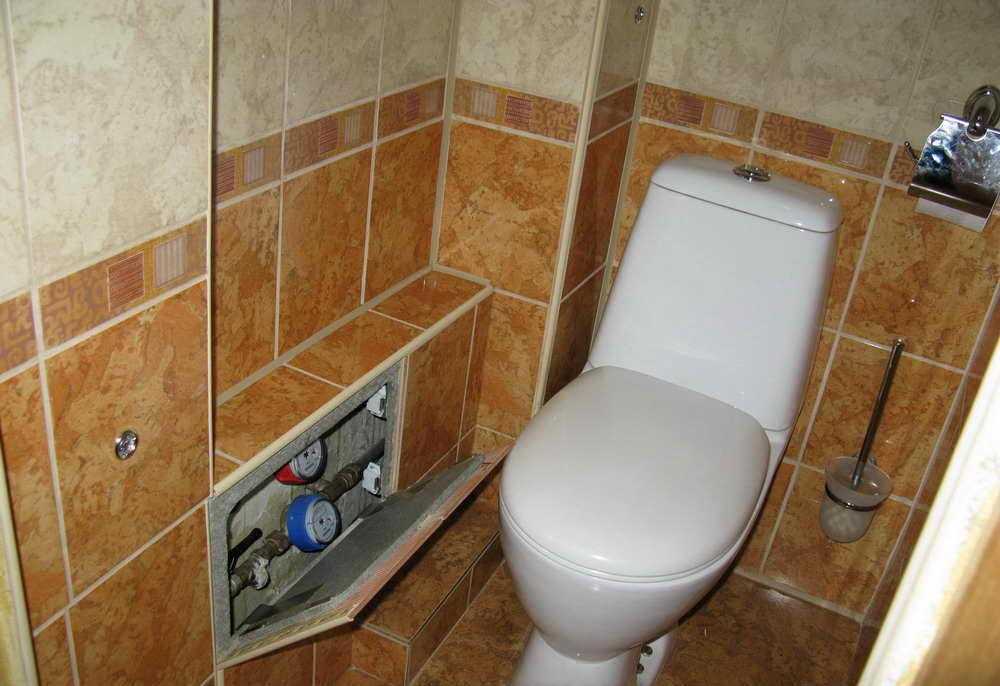
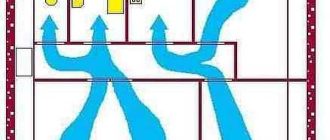
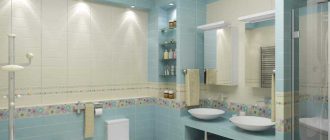
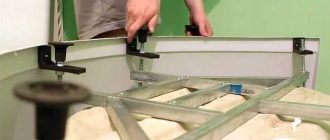
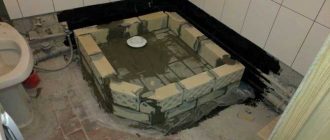
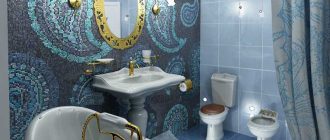
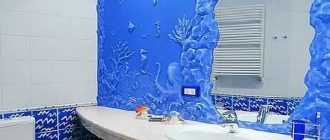
Man, last summer I had to deal with some ugly pipes in my bathroom. I just used some wooden panels to cover them up, painted ’em white to match the tiles. Looks way cleaner now! It’s all about making that space cozy and presentable, right?
Hiding toilet pipes can be a game-changer! I used some clever shelving and a few fake plants to cover mine up. It not only looks tidier but adds a nice touch to the bathroom vibe. Definitely worth a little effort to make things look neat!
Absolutely! I did something similar last year. I added some cute vintage boxes on a shelf to hide the pipes, and tossed in a few succulents. It really transformed the space! It’s amazing how a little creativity can totally change the bathroom’s vibe. Great idea!
Hiding toilet pipes can really level up your bathroom vibe! Last month, I used a combo of stylish cabinet doors and some faux wood panels. Totally transformed the space. Plus, I added a few plants on top for a fresh look. Super easy and affordable!
Absolutely! I did something similar last year. I covered my pipes with a cute cabinet and threw in some colorful tiles. It really jazzed up the room! Plants are a game-changer, too. They add life to any space. Great ideas—let’s keep our bathrooms looking fab!
I once tackled my bathroom pipes with some clever tricks! Just used a simple wooden panel to cover them up, painted it to match the decor, and it looked so sleek. Totally transformed the vibe! It’s amazing what a little creativity can do.